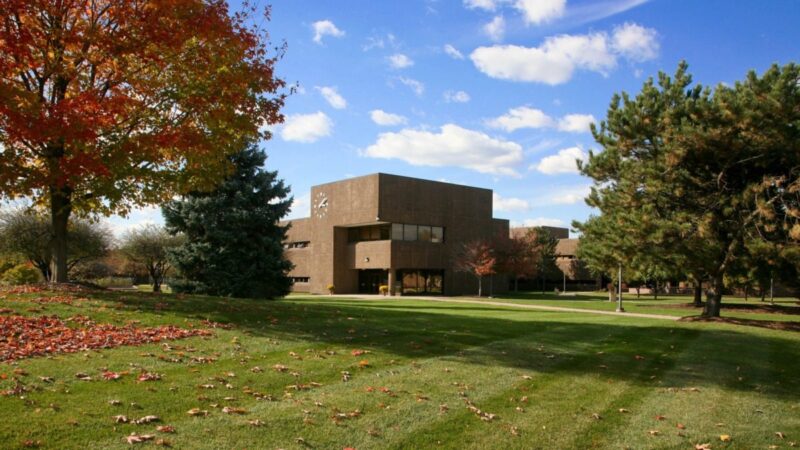
Woman holding books. (Element5 Digital/Unsplash)
While cost isn’t the only important factor in an education, these 10 cheapest colleges in Michigan are worth a second look.
The cost of colleges in Michigan has definitely been on the rise, leading many prospective students to consider whether they can afford to further their educations. While cost is certainly a consideration for choosing a college, Thomas Saelens, Site Director Lapeer and NTC-Clio Centers at Mott Community College, encourages college-bound students and families to weigh their options.
“Anything that is an investment cost should not be the primary factor in choosing which college to attend,” he explains. “Choosing a college that fits your career goals, sets you up for success, and meets other factors that are important to you as a person and student are all important factors.”
That being said, Saelens is also a proponent of students utilizing cost-effective means of education, such as occupational training programs, community college and transfer tracks, and scholarships. He notes that many students can reach their goals for far less than the first “sticker price” they see.
The 10 cheapest colleges in Michigan
If cost savings is your ultimate goal, Saelens recommends always looking at your local community college first (students who pay property taxes in their area are already supporting that community college). He notes that your local community college “will always be the lowest cost option from the starting line.” But if you’re curious about what other colleges cost in Michigan, we did the math so you don’t have to!
Based on info from the U.S. Department of Education College Navigator Tool, here is a list of the 10 cheapest colleges in Michigan. Remember, this list is just a starting point, as individual financial aid and scholarship packages will vary, and you can reach out to a school’s guidance counselor to learn more about exact pricing. Additionally, these prices are based on the last available data, so they may change with tuition updates.

Mott Community College in the fall. (Mott Community College)
1. Bay Mills Community College
Yearly tuition in-state: $3,320; Free for Federally Recognized U.S. Tribe members and families
Location: Brimley, MI
Degrees offered: Certificate, Associate, Bachelor’s
Undergrad enrollment: 577
This small yet mighty school offers everything from certificate training to full Bachelor’s degrees and has one of the most affordable tuition rates in the state. It also has distance-learning courses at an additional cost. The small campus benefits students looking for a personalized education experience, as the student-to-faculty ratio is only 9:10.
2. Keweenaw Bay Ojibwa Community College
Yearly tuition in-state: $5,000
Location: Baraga, MI
Degrees offered: Certificate, Associate
Undergrad enrollment: 222
This tribal land grant institution offers small classes, with an average class size of only 8 students. The school also prides itself on being grounded in “Anishinaabe values,” including humility, truth, and wisdom. While all tribal institutions welcome Indigenous students, these schools are open to all students, including international students.
3. Washtenaw Community College
Yearly tuition in-state: $4,584
Location: Ann Arbor, MI
Degrees offered: Certificate, Associate
Undergrad enrollment: 10,756
Conveniently located near another rather famous Michigan school in Ann Arbor, Washtenaw CC offers significantly lower tuition rates with the convenience of a large college town. Students wanting to attend the University of Michigan Ann Arbor can also work with the community college to arrange a transfer. The costs for Washtenaw depend on how many credits you take, and not only if you’re in-state but also in-district.
4. Mott Community College
Yearly tuition in-state: $4,563
Location: Flint, Lapeer, Clio, MI
Degrees offered: Certificate, Associate
Undergrad enrollment: 5,920
With both trade programs and Associate degree programs, Mott Community College is a popular affordable college option in Michigan because students can earn a full career—like becoming a Registered Nurse—or use the school as a transfer option to a larger four-year university. They also have three different campus locations throughout Michigan.

Mott Community College’s student center. (Mott Community College)
5. Wayne County Community College District
Yearly tuition in-state: $3,333
Location: Detroit, MI
Degrees offered: Certificate, Associate
Undergrad enrollment: 12,554
As one of the larger campuses on our list, Wayne County Community College offers a more immersive student experience and opportunities. For instance, students can study abroad or get involved in the school’s partnership with Detroit art galleries. The school also has six different campus locations to meet students’ needs.
6. Alpena Community College
Yearly tuition in-state: $5,130
Location: Alpena, MI
Degrees offered: Certificate, Associate, Bachelor’s
Undergrad enrollment: 1,530
A Bachelor’s of Science degree for less than $20k? Sign us up, please! This school offers a robust campus life, 75 academic programs, and sports teams, including basketball, volleyball, softball, and track and field. The campus also has two satellite locations in addition to its main campus in Alpena.
7. University of Michigan-Flint
Yearly tuition in-state: $14,190
Location: Flint, MI
Degrees offered: Certificate, Associate, Bachelor’s
Undergrad enrollment: 4,751
While you may have noticed that the U of M-Flint tuition is significantly higher than other colleges on our list, there’s a twist: U of M-Flint offers the Go Blue Guarantee, which provides free undergraduate tuition for qualified Michigan students. Students must meet certain qualifications, like being full-time (taking 12 credits per semester), be pursuing their first Bachelor’s degree, have filed their FAFSA, and have a combined family income of less than $125,000 and assets below $125,000.

University of Michigan-Flint flags on campus. (Michigan Municipal League/Flickr)
8. University of Michigan-Dearborn
Yearly tuition in-state: $14,994
Location: Dearborn, MI
Degrees offered: Certificate, Associate, Bachelor’s
Undergrad enrollment: 9,224
Similarly, U of M-Dearborn also offers the Go Blue Guarantee, with the same rules: Full-time students must have family incomes of less than $125,000 and assets below $125,000, plus a minimum GPA of 3.5. If accepted into the program, qualified students must maintain their GPA to earn a tuition-free Bachelor’s degree.
9. Saginaw Valley State University
Yearly tuition in-state: $10,800
Location: Saginaw, MI
Degrees offered: Associate, Bachelor’s
Undergrad enrollment: 6,822
To ensure we included a four-year university on our list, we chose the surprisingly affordable Saginaw Valley State University. This university has the lowest in-state tuition of any public four-year institution in Michigan. It just so happens to be my alma mater as well, and I can attest that it offers generous scholarships like the President’s Scholarship, which provides select students earning a minimum of a 3.95 GPA in high school a 100% tuition scholarship.
10. Grand Rapids Community College
Yearly tuition in-state: $4,059
Location: Grand Rapids, MI
Degrees offered: Certificate, Associate
Undergrad enrollment: 12,142
On the other side of the state in Grapid Rapids, this public community college option is one of the most affordable on our list. The school also works with adults over age 25 on low and sometimes no-cost options and offers online classes. There are over 175 programs covering everything from AI to anesthesia.

Community college students working on a computer. (Getty Images/Unsplash)
Save money with community college
It’s no accident that many of the schools on our list are community colleges. “Community colleges are the most under-appreciated asset in higher education because they have three real strategic goals for those that attend, which is why I recommend all students complete an application to their local community college regardless of their desire to attend one for three reasons,” Saelens says. He also explains the primary three goals of a community college:
1. They assist students with a career/training that requires less than four years of college.
“Most students do not know that many high-paying occupations require only two years of college or less including many skilled trades programs (welding, automotive repair, CAD, HVAC, electrician, line repair, even nursing (RN) which are all part of the occupations training programs at community colleges,” he says, adding that many of those degree programs aren’t even available at four-year schools.
“Determining if your career track requires less than four years of college and attending a community college for that training can save you two years of cost,” Saelens notes. “Community colleges are the number one option for occupational training.”
2. They help students pursuing degrees that require four years of college by providing the first two years.
Known as the “transfer track,” Saelens explains that when you go through a community college, the first two years can be aligned with four-year colleges to ensure credits will safely transfer. (He adds that you’ll want to make sure your four-year college has the same program of study for the best results.)
However, even if you don’t know your ultimate program goal, knocking your general education requirements out of the way through community college can significantly reduce costs. “Most students change majors in the first year or two and attending a community college will reduce your risk,” Saelens says. “Community colleges are the closest thing to a ‘risk-free’ option for college. I encourage every student to apply to their local community college, even if they do not think they will attend.”
3. They provide year-round courses.
Thirdly, community colleges let you take courses over the summer, even if you are enrolled at a four-year school. “You can use the community college to take courses as a ‘guest student’ that maybe you did not have time to take during your academic year or did not wish to take at your home school,” says Saelens. (He suggests applying to your community college early on, which will make it easier to be a guest student later.)

A student smiling in the library. (Getty Images/Unsplash)
Explore scholarships and financial aid
“Remember that with scholarships and aid packages, the college sticker price may not be the actual cost you will pay,” Saelens reminds prospective students and families. “It is a starting point and can be a first step in comparison but the price before aid is not always the price you pay after aid is applied.”
For example, he points to programs like Michigan Reconnect, a last-dollar scholarship program that pays for you to attend your in-district community college tuition-free, or offers a large tuition discount if you attend an out-of-district community college.
Compare college costs
Finally, Saelens recommends narrowing your choice of colleges and using comparison tools to look at the sticker prices before financial aid. Then, you can look at aid you may be eligible for from the federal government, the state of Michigan, and the institution itself.
Two helpful tools are the U.S. Department of Education College Navigator Tool and the College Scorecard, which let you search by price, location, and other factors.
This article first appeared on Good Info News Wire and is republished here under a Creative Commons license.

Group launches ballot initiative to fund public schools by taxing wealthy Michiganders
BY BEN SOLIS, MICHIGAN ADVANCE MICHIGAN—Underfunded public schools continue to be a political football in the Michigan Legislature, but a new...

State program brings fourth graders to state parks
By Kayte Marshall, Capital News Service LANSING – In a world dominated by smartphones and screen time, the Department of Natural Resources aims to...

Male teacher shortage continues to be a problem in Michigan
By Ruth Thornton, Capital News Service LANSING – A recent report found widespread teacher shortages to be a continuing problem in Michigan, with...

Michigan students rally at State Capitol to defend public education
Students from across the Great Lakes State, alongside educators and advocates, recently gathered in Lansing to fight for a future where every...

High school seniors applying for federal student aid faster than in past years
By Emilio Perez Ibarguen, Capital News Service LANSING — After years of declining participation, high school seniors are outpacing last year’s...







